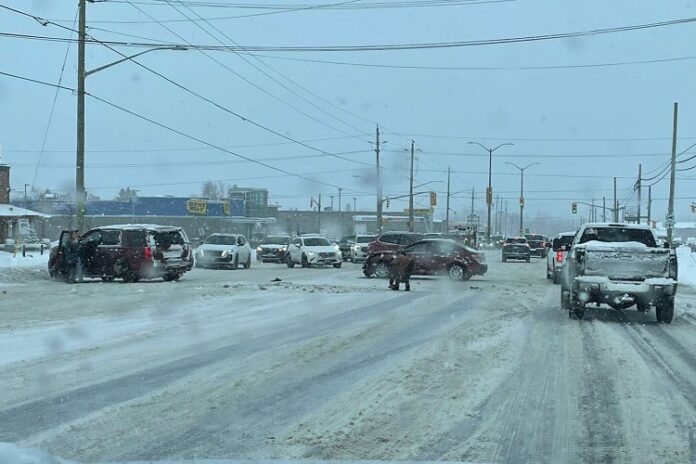As the so-called “snow bomb” explodes on to us with residual effects that could last a couple days, Timmins Police communications coordinator Marc Depatie reminds us to drive safely, if we have to drive at all.
He draws particular attention to adjusting your driving to the road conditions, and keeping two or three car lengths between your car and the one in front of you.
“If you cannot see that vehicle’s rear wheels, you are way too close,” he states. “If this (seeing the rear wheels) becomes a driving habit that you adopt, you will find that you will have a less anxious commute to wherever you happen to be attending.”
Depatie likes to say that there’s no need to be in the same vehicle as the guy in front of you.
“If all they can see is your grill as they look back, then you’re intimidating that driver. It’s unethical, it’s unsafe, it leads to road rage circumstances. These are avoidable sets of circumstances, of course.”
When any winter storm hits our area, the Timmins Police Service has safe winter driving tips to local drivers to enhance safety and reduce collisions.
1) Take time to ensure that your vehicle is mechanically fit for the rigors of winter driving: Winter tires are always recommended, as they will provide superior traction where road conditions are affected by snow and ice.
2) Keep a proper snow brush and ice scraper in your vehicle and at the ready. f
3) Always take the requisite time necessary to clear off your windshield and all your windows with special attention being paid to mirrors. Your visibility should be that of the “360 degree” type at all times
4) Take the snow load off of your vehicle as this poses a serious visibility issue for other drivers – becoming a portable snow storm is not in keeping with road safety.
5) Start from a stopped position smoothly and slowly: quick accelerations lead to spinning tires and loss of control.
6) Try to avoid making any abrupt turns or stops when driving. Having to skid to a stop is an indication that you are travelling too fast for road conditions. Drive in control at all times.
7) Increase the distance between your vehicle and the vehicle you are following. Tailgating is a form of aggressive driving and leads to preventable collisions, especially in the winter. Stopping distances increase significantly on snow covered or icy roads.
8) Ease into your turns by braking before making them. Gently apply your brakes to reduce speed before entering into any turn. Once you’ve rounded the corner, accelerate carefully.
9) Should you find yourself in a skid, you need to remain calm, turn into the skid, and take your foot off the brakes. Gentle acceleration will allow you to regain control.
10) Keep your light on at all times. This practice increases your visibility so that other motorists see your vehicle and are aware of your presence on the road.
11) Try to avoid using your cruise control features in the winter. Quite often a loss of control can result from your vehicle accelerating unexpectedly on icy or snowy road surfaces.
12) Most modern vehicles come equipped with some form of anti-lock braking systems (ABS), so it is recommended that braking be completed with the use of constant pressure on the brake pedal to better allow the system to reduce your speed safely
13) Avoid distractions: cell phone use, changing radio setting, or any other activity that takes your attention away from the task of driving will lead to precarious situations. Winter driving demands all your attention in order to reach your destination safely. Drive with a sense of focused anticipation: concentrate on your upcoming intersection or expected turns and give yourself sufficient room to react to the unexpected.
It is further recommended that your vehicle should be equipped with emergency items:
– a shovel
– battery cables
– a flashlight.
– a first aid kit
Winter driving means being prepared and forewarned so that the number of collisions and near-miss situations are reduced.



